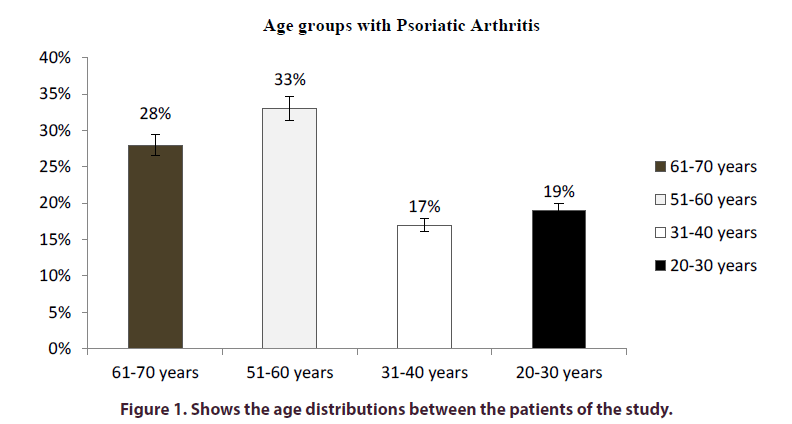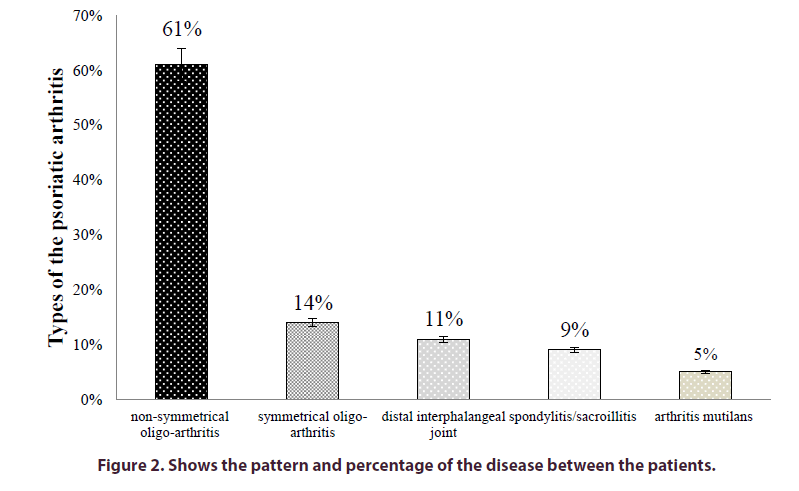Research Article - International Journal of Clinical Rheumatology (2021) Volume 16, Issue 4
Clinical presentation of psoriatic arthritis among sudanese: hospital based study
- *Corresponding Author:
- Elmujtba Adam Essa
Department of Clinical Medicine, Medical and Cancer Research Institute, Nyala, Sudan
E-mail: Awadali818@yahoo.com
Abstract
Back ground: Psoriasis is a common papulo-squamous disorder affecting 2% of the population and is characterized by well demarcated red scaly plaques. Psoriatic Arthritis (PsA) may be defined as an inflammatory arthritis which is seronegative for Rheumatoid Factor (RF) and enthesitis that is associated with psoriasis. The aims of our study is to identify different clinical presentations and types of psoriatic arthritis.
Methods: This is a descriptive cross sectional hospital based study conducted at Omdurman military hospital, Khartoum, Sudan, for a period of six months. The study included 96 patients confirm diagnosed by dermatologist as psoriasis, the data obtain with designed questionnaire contains the clinical presentations of the disease, lab result and radiological imaging, the study analyzed by SPSS v.20 by using one way a nova method to determine the P. value.
Results: From the total number of patients with Psoriasis, more than one third was psoriatic arthritis, 6% of patients with psoriatic arthritis were oligo-arthritis joint involvements, 14% were polyarthritis, 9% were distal inter phalangeal joint, 9% were spondylitis/sacroillitis and the remaining 5% were arthritis mutilants.
In conclusion: the study found out most common pattern of joint involvement in psoriatic arthritis is oligoarthritis, which is not known to be common in psoriatic arthritis previously.
Keywords
oligoarthritis • psoriasis • psoriatic arthritis • sudan
Introduction
Psoriasis is a common papulosquamous disorder affecting 2% of the population and is characterised by well-demarcated red scaly plaques. The skin becomes inflamed and hyper proliferates to about 10 times the normal rates. It affects male and females equally and can affect all races. The age of onset occurs in two peaks [1, 2]. Early-onset (age 16 – 22) is commoner and it is often associated with a positive family history. Late-onset disease peaks at age 55 - 60 years [2, 3].
Psoriatic Arthritis (PsA) may be defined as inflammatory arthritis which is seronegative for Rheumatoid Factor (RF) and enthesitis that is associated with psoriasis. PsA has a worldwide Prevalence among psoriasis patients ranging from 6% to 42%. PsA is inflammatory arthritis in which initial musculoskeletal symptoms are more often insidious in onset, rather than acute [4]. Joint discomfort, more than pain, characterizes PsA. However, asymptomatic disease, even with evidence of radiographic damage of the involved joints, is not uncommon.
There is no definitive test to diagnose psoriatic arthritis as mostly the diagnosis is on a clinical base. Although Symptoms of PsA may closely resemble another disease such as rheumatoid arthritis [5]. The aim of this study is to Study different clinical presentation of psoriatic arthritis among adult Sudanese patients.
Material and methods
This is a descriptive cross sectional hospital based study, conducted at Omdurman Military Hospital (OMH), Khartoum, Sudan. Between the period of September 2015 to June 2016. The study included 36 patients of psoriatic arthritis from 96 patients of psoriasis. All the patients were admitted or seen in referred clinic during the study period who were diagnosed with psoriasis. Data was collected by using well-structured questionnaire retrieving information from the patients. A full detailed history was taken from the patients, after completion, the data were collected by using a designated questioner which contains: age, gender, symptoms and signs of the disease. Data were analyzed by using SPSS (Statistical Package for Social Sciences).
Results
In This study we found that 61% of all the psoriatic arthritis patients are male, while the remaining 39% are female. Regarding the age related prevalence with the diseases, are as follow; age group between 51-60 years have the highest affection by the disease with 33%, followed by age group from 61-70 years with 28%, then from 20-30 years by 19% and the least age group is those between 31-40 years by only 17% (Figure 1). The most clinical presentations and types of psoriatic arthritis in this study was non-symmetrical oligo-arthritis in 61% of the total patients, followed by 14% with symmetrical oligo-arthritis, 11% with distal interphalangeal joint, 9% with spondylitis/sacroillitis and the fewest type was arthritis mutilans in about 5% (Figure 2). In regard to the extra articular manifestations of PsA, the study found that patients presented with nail changes, conjunctivitis and bowel symptoms. By 58%, 33% and 8% respectively.
Discussion
Psoriatic Arthritis (PsA) has been defined as an inflammatory arthritis, usually seronegative, associated with psoriasis. Among patients with psoriasis the prevalence of inflammatory arthritis varies from 6% to 42% [6]. Thus, there is a distinct increase in the prevalence of inflammatory arthritis with varied patterns of presentation that are associated with psoriasis [7]. The current study was conducted among 96 patients diagnosed as psoriasis, and psoriatic arthritis was detected among 36 patients. PsA can present with oligo-articular joint involvement that is typically asymmetric or can present as polyarticular which is affecting more than five joints, generally with a symmetric distribution similar to that of rheumatoid arthritis [8,9].
This study identified that most common pattern of joint involvement in PsA patients is oligoarthritis. However, previous reports have indicated un-similar results as polyarthritis is the most common presentation followed by oligo-arthritis, distal involvement alone occurs in less than 20% of cases and may be associated with spondyloarthritis, This may be due to some patients can presented with more than one pattern and may change the pattern of their arthritis during follow up. While distal arthritis and arthritis mutilans are considered the most specific for psoriatic arthritis, although, they are not commonly seen [10].
The study also found that males were more affected by PsA than females by a ratio of 3:1, although gender-related differences have not been thoroughly explored in PsA but some studies revealed that males accumulate more axial and peripheral joints damage compared to females [11], also some previous studies have addressed the potential role of hormonal influences in the pathogenesis of PsA [12], yet The explanation for these differences is not fully understood.
Among the recognized patterns of PsA initially described by Moll and Wrights, the distal inter phalangeal joint predominant pattern may be the most readily recognized because it is unique to PsA, However occur in only 5% to 10% of patients. Nail lesions occur in 58% of the study patients in contrary to other studies where they found more or less than 85% Nail changes on PsA patients. This is due to the anatomical connection between the nail matrix and the enthesis of the distal interphalangeal [13].
Conclusion
The most common pattern of joint involvement in psoriatic arthritis is asymmetrical oligoarthritis, Male are commonly been affected than females, nail lesions occurs in 58% of patients with psoriatic arthritis, 33% of the patients with psoriatic arthritis has developed conjunctivitis.
Disclosure
No conflict of interest.
Funding
No fund have been received.
Ethical approval
A written consent was obtained from the patient and Sudan federal ministry of health and Sudan Medical Specializations board.
Availability of data and materials
All the data used in the study are available from the first and corresponding author on reasonable request.
References
- Lebwohl MG, Bachelez H, Barker J et al. Patient perspectives in the management of psoriasis: results from the population-based Multinational Assessment of Psoriasis and Psoriatic Arthritis Survey. J. Am. Acad. Dermatol. 70(5), 871–881. e1–30 (2014).
- Rachakonda TD, Schupp CW, Armstrong AWet al. Psoriasis prevalence among adults in the United States. J. Am. Acad. Dermatol. 70(3), 512–516(2014).
- Menter A, Gottlieb A, Feldman SR et al. Guidelines of care for the management of psoriasis and psoriatic arthritis: Section 1. Overview of psoriasis and guidelines of care for the treatment of psoriasis with biologics. J. Am. Acad. Dermatol. 58(5), 826–850 (2008).
- Sheu J-J, Wang K-H, Lin H-Cet al.Psoriasis is associated with an increased risk of parkinsonism: a population-based 5-year follow-up study. J. Am. Acad. Dermatol.68(6), 992–999 (2013).
- Lebwohl MG, Kavanaugh A, Armstrong AW et al.US perspectives in the management of psoriasis and psoriatic arthritis: patient and physician results from the population-based multinational assessment of psoriasis and psoriatic arthritis (MAPP) survey. Am. J. Clin. Dermatol. 17(1), 87–97 (2016).
- Slobodin G, Rosner I, Rozenbaum M et al. Psoriatic arthropathy: where now?. Isr. Med. Assoc. J. 11(7), 430–434 (2009).
- Palmer D, Miedany YE. Early psoriatic arthritis: facing the challenge. Br. J. Nurs. 22(17), 1014–1020 (2013).
- Gladman DD. Clinical features and diagnostic considerations in psoriatic arthritis. Rheum. Dis.Clin. North. Am. 41(4), 569–579 (2015).
- Felquer MA, FitzGerald O. Peripheral joint involvement in psoriatic arthritis patients. Clin. Exp. Rheumatol. 33(93), S26–S30 (2015).
- Haglund E, Bremander A, Petersson IF et al. Prevalence of spondyloarthritis and its subtypes in southern Sweden. Ann. Rheum. Dis. 70(6), 943–948 (2011).
- Queiro R, Tejón P, Coto P et al. Clinical differences between men and women with psoriatic arthritis: relevance of the analysis of genes and polymorphisms in the major histocompatibility complex region and of the age at onset of psoriasis. Clin. Dev. Immunol.2013, 482691(2013).
- Alenius G-M, Stenberg B, Stenlund Het al. Inflammatory joint manifestations are prevalent in psoriasis: prevalence study of joint and axial involvement in psoriatic patients, and evaluation of a psoriatic and arthritic questionnaire. J. Rheumatol. 29(12), 2577–2582 (2002).
- Dhir V, Aggarwal A. Psoriatic arthritis: a critical review. Clin. Rev. Allergy. Immunol. 44(2), 141–148(2013).




